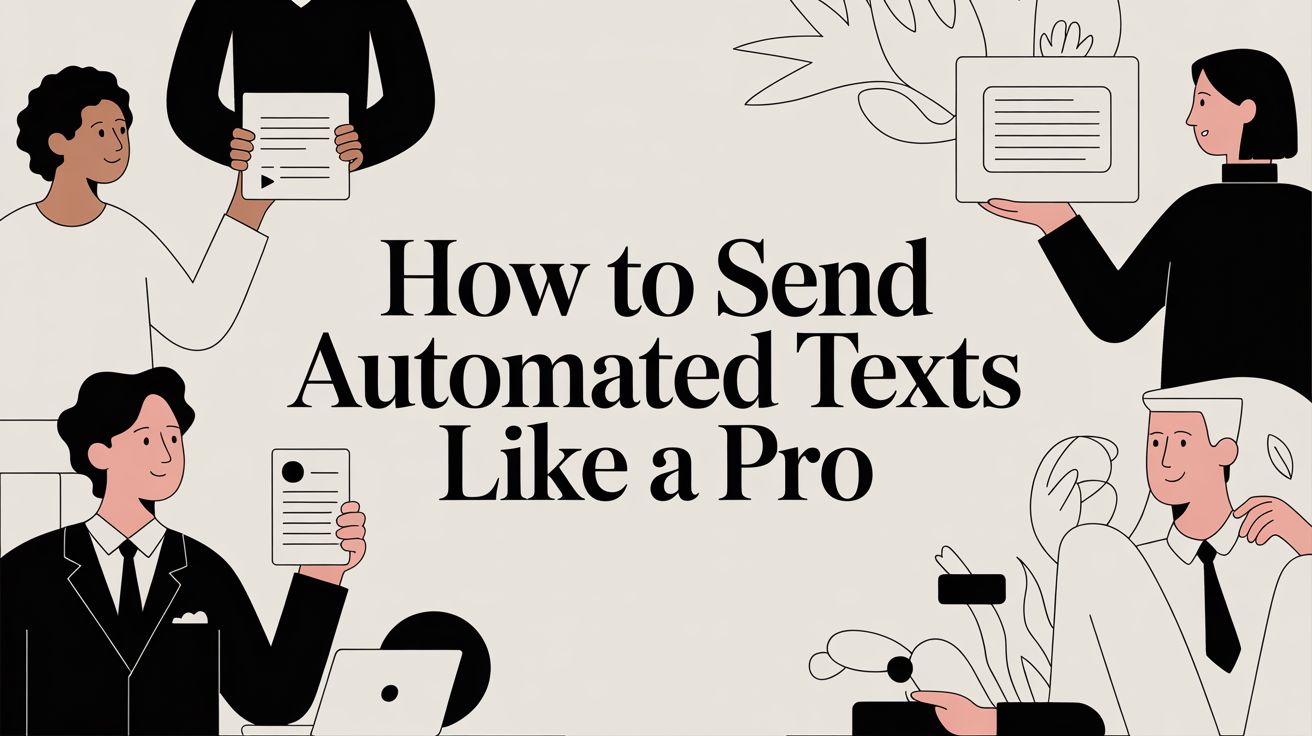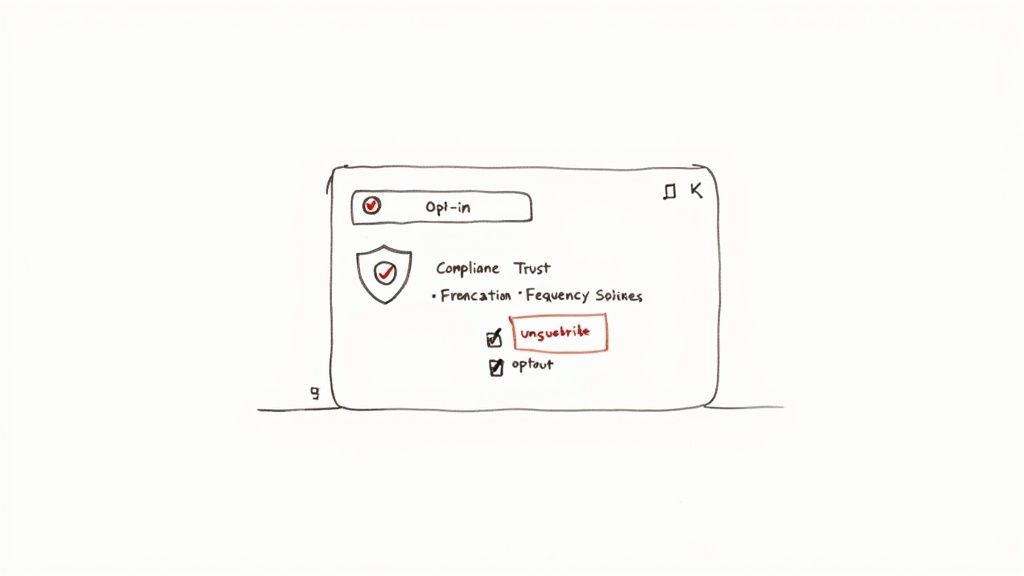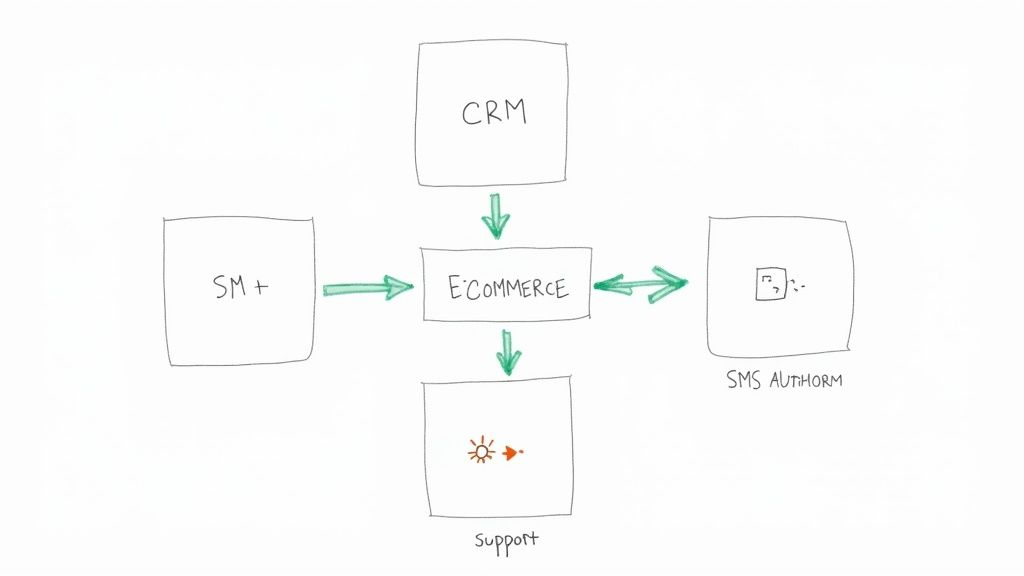See a Demo
You're just one step away from seeing Call Loop in action.
Enter your information below to watch a demo right now.

When you break it down, sending automated texts is pretty straightforward. You pick a platform, decide on a trigger (like a new customer signing up), write out your message sequence, and hit "go." It’s a simple concept that lets you connect with people at just the right moment, without you having to lift a finger every time.
Let's get past the nuts and bolts and talk about what this really means for your business. This isn't just about blasting out messages. It’s about creating conversations that feel timely and relevant, pushing people to take action.
Think of it as the difference between a generic flyer and a personalized note that lands on someone's desk at the exact moment they need it.
With smart automation, you can connect with customers at critical points in their journey. For example, what happens when someone leaves a full shopping cart behind? A perfectly timed text with a small discount can be the gentle nudge they need to finish the purchase. That’s how you turn a potentially lost sale into actual revenue.
Automated texting has come a long way. The very first SMS was sent back on December 3, 1992—it was just a simple "Merry Christmas" message. Since then, it has exploded into a massive marketing force.
The SMS marketing industry is on track to become a $12.6 billion sector by 2025, and it's all thanks to the fact that everyone has a phone and the automation tools have gotten incredibly powerful. Today, something like 80% of businesses use software to run their text campaigns, doing things that would have seemed impossible just a few years ago. You can see more on the growth of SMS marketing at OptiMonk.
This explosive growth is happening for a reason: texting gets results that other channels can only dream of.
The real magic of automated texting is how it turns one-way announcements into genuine two-way conversations. You’re not just broadcasting; you’re building relationships at scale, one perfectly timed, relevant message at a time.
Ultimately, figuring out how to send automated texts is about more than just saving a few hours. It’s about creating a system that nurtures your customer relationships, builds loyalty, and directly impacts your bottom line.
Alright, you've seen what automated texting can do. Now it's time to roll up your sleeves and actually build your first campaign. A winning strategy isn't just about the messages you fire off; it's about the entire customer journey you're creating. This means doing a bit of planning, writing some thoughtful messages, and having a crystal-clear idea of what you want to accomplish.
The whole thing really boils down to three key stages: figuring out your goals and triggers, building out your message sequences, and then finally, launching the campaign.

As you can see, a great automated campaign is a deliberate process. It's about moving from a smart strategy to a flawless execution, not just sending random texts.
Every automated SMS campaign kicks off with a trigger. Think of a trigger as the specific action or event that starts your automated message sequence. Nailing this is critical because it ensures your message shows up at the most relevant, high-impact moment possible.
Instead of just blasting out generic updates, triggers let you respond directly to what a customer is doing. This flips the script from a one-way monologue to a timely, helpful conversation.
The trick is to find those key moments in the customer lifecycle where an automated message can remove a point of friction, answer a burning question, or just provide a little extra value—all without you having to lift a finger.
So, what are some of the most effective triggers we see people using? Here’s a quick breakdown of the most common ones and how they work in the real world.
By matching the right trigger to the right moment, you create a system that feels incredibly personal and responsive, even though it's completely automated.
Once you’ve locked in your trigger, it's time to write the messages. SMS is a personal, direct channel, and your copy needs to match that vibe. Keep it concise, clear, and conversational.
Let's be real: attention spans are short, and phone screens are small. You have to get straight to the point.
Generic, faceless messages are easy to ignore. Using personalization tags like [FirstName] makes your text feel like it was written just for that one person. A simple "Hi [FirstName]," is so much more engaging than a cold, robotic message. It’s a small detail that makes the interaction feel one-on-one.
Your automated campaign shouldn't be a one-and-done message. It should be a sequence—a conversation that unfolds over a bit of time. These sequences, often called drip campaigns or SMS autoresponders, are designed to guide the user on a specific journey.
For instance, a welcome flow for a new subscriber might look something like this:
This approach builds the relationship without spamming or overwhelming the new subscriber. If you want to dive deeper into setting up these kinds of sequences, check out how powerful SMS autoresponders can manage all the scheduling and logic for you.
By carefully choosing your triggers and crafting thoughtful message flows, you'll build an automated system that doesn't just save you time—it builds stronger and more profitable relationships with your customers.
Diving into automated SMS comes with a few ground rules, and knowing them isn't optional. Getting this part wrong can land you in hot water with some hefty fines, but just as important, it can wreck the relationship you have with your audience. Think of compliance less like a hurdle and more like the foundation for building real, lasting customer trust.
A subscriber who trusts you is infinitely more valuable than one who feels spammed. When people know you respect their inbox and their privacy, they're way more likely to actually read your messages and stick with your brand. It's all about being effective and ethical.

Let’s get straight to the point: the single most critical piece of sending automated texts is getting explicit permission first. This isn't just a friendly suggestion; it's a legal mandate under regulations like the Telephone Consumer Protection Act (TCPA) in the United States. You absolutely must have clear, documented consent before a single automated message goes out.
So, what does "clear consent" actually look like in the real world?
Just because you have a customer's phone number from a past purchase doesn't mean you can start blasting them with marketing texts. That's a huge no-no. You need their specific thumbs-up for that type of communication. This upfront clarity is what keeps you out of trouble and ensures you're only talking to people who actually want to hear from you.
Just as important as getting permission to text is making it dead simple for people to take it back. Every single automated marketing campaign you send must include a clear, easy way for subscribers to opt out. This is another non-negotiable part of the TCPA.
The universal method is honoring keywords like STOP, END, CANCEL, UNSUBSCRIBE, and QUIT. When someone sends one of those words, your system must immediately yank them from that list and fire back a final confirmation text.
Your opt-out instructions shouldn't be buried in the fine print or require a treasure map to find. A simple "Reply STOP to unsubscribe" at the end of your texts is standard practice. It shows you respect that the user is in control.
Failing to process an opt-out request is a serious violation. It shatters trust in an instant and can lead to major legal headaches. For a deeper dive into responsible messaging, you can check out a detailed anti-spam policy to guide your strategy.
While the legal stuff sets the minimum bar, building genuine trust means going the extra mile. It’s about treating your subscribers' phone numbers with the same respect you'd want for your own. That boils down to being transparent and predictable.
Here are a few best practices that build that kind of confidence:
At the end of the day, every text you send is a chance to either strengthen or weaken your customer relationships. By making consent a priority, respecting opt-outs, and communicating like a human, you'll build a program that sidesteps legal trouble and grows a loyal, engaged audience.
You've done the hard work of designing your campaign, writing your messages, and making sure you're compliant. Awesome. Now it's time to actually launch this thing.
But hold on. Going live isn't just about flipping a switch. It’s more like a pilot's pre-flight check. A few minutes of careful testing right now can save you from embarrassing mistakes and make sure your campaign starts off on the right foot. You want a seamless experience for your customers, and this is how you deliver it.
Before any automated campaign goes live, I always run through a quick but essential checklist. This simple process catches the common—and often painful—errors that can sink an otherwise great campaign, like broken links or personalization tags that fail to pull in a customer's name.
Here's what to check:
[FirstName] actually show up as "John," or does it literally say [FirstName]? Broken tags are a dead giveaway that a message is automated and just feels sloppy.Knocking out this checklist ensures a smooth launch and helps you look professional from that very first text.
Once your campaign is humming along, the real work starts. Sending messages is the easy part. Understanding their impact is what separates the campaigns that fizzle out from the ones that become serious growth drivers.
Don't get lost in a sea of data. Just focus on the Key Performance Indicators (KPIs) that tell you if your strategy is actually working.
Here are the big three to watch:
These metrics tell the story of your campaign’s performance, showing you exactly where you need to tweak things.
And the potential here is massive. Automated texting has completely changed the game with its incredibly high open and response rates. We're talking a staggering 98% open rate and a 45% response rate on average—numbers that email marketing can only dream of. This immediacy leads to real results: around 75% of SMS recipients convert on offers they get via text. You can dive deeper into the latest text marketing statistics to see the full picture.
To truly dial in your performance, you have to experiment. A/B testing (or split testing) is just a fancy way of saying you send two slightly different versions of a message to see which one performs better. It’s a simple, data-driven approach that takes all the guesswork out of your strategy.
You can test pretty much anything:
My best advice? Start small with your tests. Only change one thing at a time—like the headline or the CTA—so you know exactly what caused the shift in performance. A bunch of small, consistent improvements will lead to massive gains over time.
By continuously launching, measuring, and testing, you turn your automated texting from a "set it and forget it" tool into a dynamic growth channel that gets smarter with every single message you send.
Your automated campaigns are great on their own, but the real magic happens when your texting platform stops being an island. The smartest strategies I've seen all have one thing in common: they connect SMS with the other tools you use every single day. This creates one cohesive, intelligent system that talks to your customers in real time.
When your systems can talk to each other, you unlock a whole new level of personalization. Imagine your SMS platform knowing the exact moment a customer buys something, gets a support ticket resolved, or even just opens a specific email—and then instantly triggering the perfect text. That's the power we're talking about.

Your CRM is the heart of your customer data. It knows who your customers are, what they've bought, and their entire history with your brand. By integrating your CRM with your SMS platform, you turn all that static data into dynamic action.
Instead of sending generic blasts, you can trigger incredibly relevant messages based on where a customer is in their journey or what they've purchased in the past. This makes the experience feel like it was crafted just for them.
Here are a few real-world examples:
This direct line between your CRM and texting tool is what makes every message feel timely and impactful.
What if your tools don't have a direct, built-in integration? No problem. This is where a service like Zapier comes in. Think of Zapier as the universal translator for your apps, letting you connect thousands of different tools without writing a single line of code. It all works on a simple "When this happens, do that" logic.
This completely opens up the possibilities for your text automation. You're no longer stuck with just the triggers your SMS platform offers.
Integrations are like building bridges between your different business tools. A text message can now be the final, crucial step in a workflow that starts on your website, moves through your help desk, and gets logged in your CRM.
For instance, you could build a "Zap" that automatically sends a text whenever:
The flexibility is almost endless. You can see just how powerful these connections can be by exploring the possibilities of a Zapier integration to automate text messages, which can connect to over 4,000 other applications.
Let's see how this works in the wild. An e-commerce store could connect its Shopify store to its email and SMS tools. When a customer opens an email about a new product, a Zap could trigger a text message 24 hours later, asking if they have any questions and offering a small discount to nudge them toward a purchase.
A service-based business could connect its Calendly scheduling tool. The moment a client books a meeting, they get an instant confirmation text. Then, 24 hours before the meeting, another automated text goes out as a reminder, which can drastically reduce no-shows. For an in-depth look at connecting Facebook leads with SMS, check out this ultimate guide to automated SMS marketing.
By integrating your tools, you're not just sending texts; you're building a cohesive, responsive system. This unified approach makes sure you're always delivering the right message at the perfect moment, creating an experience that builds loyalty and drives real growth.
Jumping into automated texting can bring up a lot of questions. I get it. From picking the right tools to figuring out costs and timing your messages just right, there are a lot of moving parts.
This section is designed to cut through the noise and give you clear, straightforward answers to the questions I hear most often.
The honest answer? There’s no single "best" software for everyone. It really boils down to what you need to get done. The perfect platform for a local dentist sending appointment reminders is going to look totally different from what a big e-commerce brand needs for its marketing campaigns.
Instead of hunting for one magical platform, start by defining your main goal.
Once you know what you’re solving for, you can compare features and pricing. Most importantly, always take the free trial for a spin. You need to feel comfortable with the user interface and workflow before you commit.
The cost can vary quite a bit, depending on the provider, your message volume, and the type of messages you're sending. Most services use either a monthly subscription model (which includes a set number of messages) or a pay-as-you-go plan where you buy message credits upfront.
A key thing to remember is that MMS messages—the ones with pictures, GIFs, or videos—will always cost more than a standard SMS. When you’re looking at pricing, keep an eye out for any hidden fees, like charges for a dedicated phone number or setup costs.
The real question isn't just about the cost, but the return. SMS marketing delivers an exceptionally high ROI. When a single campaign can recover abandoned carts or slash no-shows by 20%, the service often pays for itself almost immediately.
While there are apps that might let you do this, you absolutely should not use your personal number for business texting. It’s unprofessional, impossible to scale, and opens you up to serious legal trouble with regulations like the TCPA. It’s just not worth the risk.
Professional platforms are built to handle these challenges. They use approved business numbers (like short codes or 10DLC numbers) and give you all the tools you need for managing consent, tracking results, and handling opt-outs legally. Using a dedicated business line keeps everything separate and protects both you and your customers.
Respecting your customer's time is everything. Get this wrong, and you’ll lose subscribers fast. As a general rule, stick to normal waking hours—think somewhere between 9 AM and 8 PM in the recipient's local time zone. A text at 6 AM or 11 PM is a guaranteed way to get an opt-out.
The "best" time, however, really depends on what your message is about.
Ultimately, the only way to know for sure is to test. Send campaigns at different times, watch your engagement data like a hawk, and let the results—not just guesswork—guide your timing.
Ready to create seamless, multi-channel automated campaigns that drive real results? Call Loop provides all the tools you need—from SMS and voice broadcasting to advanced drip campaigns and Zapier integrations—to connect with your audience at the perfect moment. Start your free trial today and see how easy compliant, high-impact outreach can be.
Trusted by over 45,000 people, organizations, and businesses like